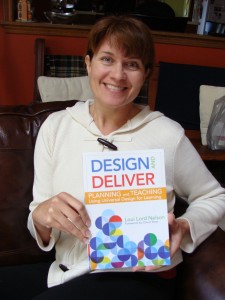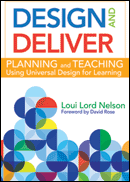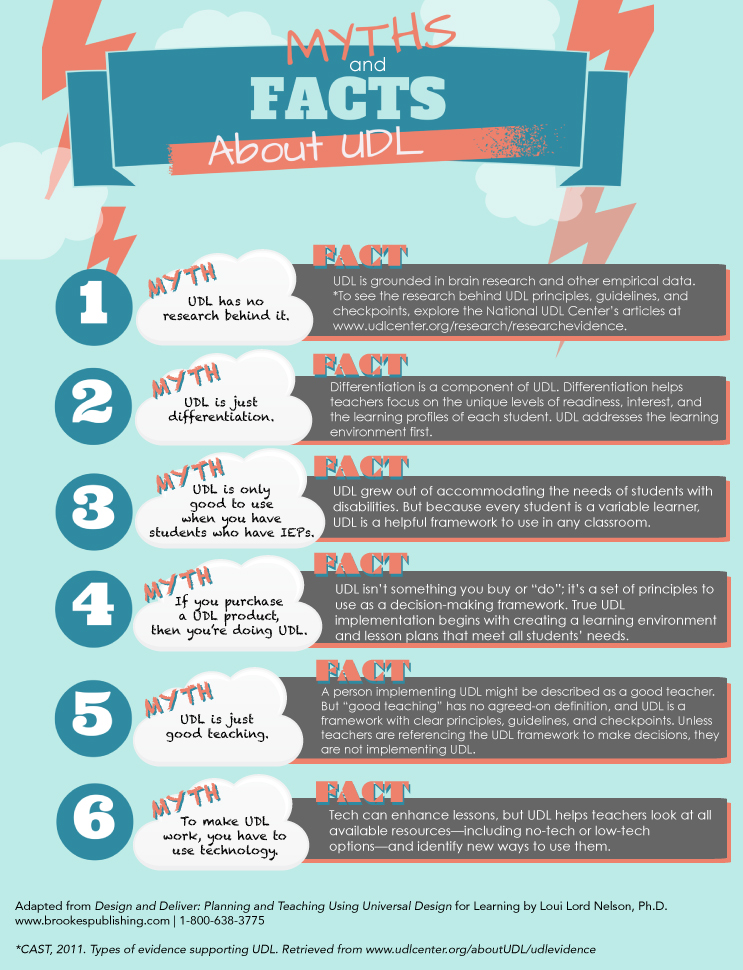6 UDL Myths (and the Facts Behind Them!)
April 30, 2015
If you read the latest books and blogs on inclusive education, you’ve probably heard a lot about the potential benefits of universal design for learning (UDL). Stronger student engagement. Sharper executive function skills. Increased access to the general curriculum for all students.
The UDL framework holds such great promise—but with so many myths and misconceptions floating around, those three letters can seem a little mysterious. What is UDL, really? Is it just differentiation in disguise?

To answer these questions, let’s check in with UDL expert Loui Lord Nelson, whose book is making a big splash in the world of inclusive education. In Design and Deliver, Nelson takes on 6 stubborn myths about UDL and debunks them one by one. Whether you’re a newbie weighing the benefits of implementing UDL in your own classroom or a UDL devotee hoping the change the minds of skeptics, this post gives you the fast facts you need to move forward.
[INFOGRAPHIC: Grab and share the infographic version of these 6 mythbusters below this post!]
MYTH #1: UDL has no research behind it.
FACT: The UDL framework is solidly grounded in brain research and other empirical data. (To see the research behind UDL principles, guidelines, and checkpoints, explore the National UDL Center’s archive of articles.)
Quantifying the positive effects of UDL is a little challenging: though UDL guidelines stay the same, implementation will look different from school to school based on each teacher’s knowledge and available resources. But early UDL research has been promising. In two recent studies, Nelson points out, students performed better on standardized measures when they used resources designed with the UDL framework—and had teachers who used UDL guidelines to craft their lessons and design the classroom environment.
MYTH #2: UDL is another word for differentiation.
FACT: Differentiation is just one component of UDL. Nelson describes the difference this way: Differentiation is a strategy that helps you address each student’s individual levels of readiness, interest, and learning profiles. UDL is an overarching approach that addresses the environment first, including the physical location and the lesson, unit, and/or curriculum. When you address the whole environment up front, you make sure all students have full access to everything in the classroom, regardless of their needs and abilities.
MYTH #3: UDL is only good to use when you have students with IEPs.
FACT: It’s true that UDL grew out of accommodating the individual needs of students with disabilities. But because every student is a variable learner, UDL is a helpful framework to use in any classroom, especially one that includes students of all ability levels. When you design your lessons based on the UDL framework, you create an accessible learning environment where all of your students have the best chance to learn.
MYTH #4: If you purchase a UDL product, then you’re doing UDL.
FACT: UDL isn’t something you buy or “do”; it’s a set of principles and guidelines to use as a decision-making framework. True UDL implementation begins with the learning environment first—creating a classroom and lesson plans that meet all students’ needs. UDL-aligned products and strategies can be valuable tools, but they’re just a part of your journey toward UDL implementation, not a one-stop solution.
MYTH #5: UDL is just good teaching.
FACT: A person implementing UDL might be described as a good teacher—that part is definitely true! But simplifying UDL as “good teaching” is misleading. Good teaching has no single, agreed-on definition, whereas UDL is a framework with clear principles, guidelines, and checkpoints. Teachers who work hard to include all children in their classrooms and remove barriers to learning are doing a lot of things right, but unless they’re referencing the UDL framework to make decisions, they aren’t implementing UDL.
MYTH #6: To make UDL work, you have to use technology.
FACT: Tech can be a great way to enhance lessons and engage students. But if your school doesn’t have the funds for fancy technology, that doesn’t mean UDL is out of your reach. “For centuries teachers have used the resources available to communicate ideas to students,” Nelson says. “UDL helps teachers look at available resources and potentially identify new ways to use them.”
Nelson suggests that teachers collaborate with peers to identify no-tech or low-tech options that support students’ learning outcomes. (A good place to start is #udlchat on Twitter, a hashtag for sharing UDL tips and tricks. UDL experts also use the hashtag for a regularly scheduled professional development chat—check #udlchat for the date and time of the next one!)
What do you think? Have you heard any other stubborn UDL myths? What’s the #1 misconception most people have about UDL? Tell us your thoughts in the comments below!
Design and Deliver is an amazing UDL primer. Check out the reviews and sample a chapter here.
SHARE THE INFOGRAPHIC!
Here’s a neat infographic that sums up the key points in this post. Share it around and help spread the word about UDL (click twice to view at full size):






Write a Comment
Your email address will not be published. Required fields are marked *
comments
Kelli Tharrington says
It is extremely important to implement UDL in the classroom. Every child learns differently and the most memorable assesments are the ones in which the student is in control. Including options for movement, and kinesthetic repsonses are so important. It makes it more fun for the teacher too I must admit. But more importantly it takes the student out of the mold of average and lets them explore subject material in their own way.
Enid says
I am intrigued by the concept of UDL. I am excited to learn all the aspects and how to implement this in my classroom.
Post a Comment